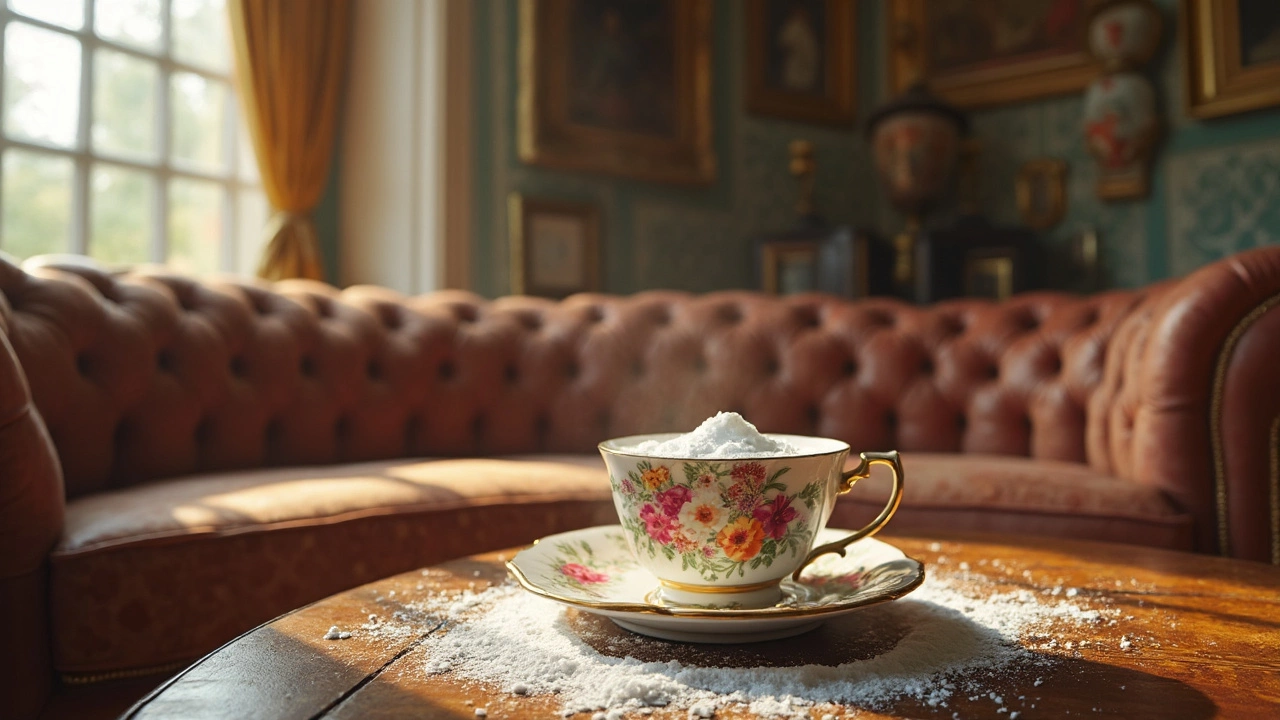Baking soda is like that jack-of-all-trades buddy you never knew you needed for your home-cleaning toolbox. You might have it lurking in your kitchen, waiting to save the day. So, how does it fare when it comes to cleaning upholstery? Let’s break that down.
Imagine you're hosting a movie night, and your friend, who’s basically a human tornado, spills soda on your plush couch. Before you freak out, grab some baking soda. It's more than just a cake ingredient – it's a natural cleaning agent, soaking up spills like nobody's business.
To start, sprinkle a generous amount of baking soda over the affected area. It absorbs moisture and helps lift stains, making them easier to clean. Give it about 15 minutes; patience is key here. While waiting, maybe make yourself a coffee because this magic takes a little while to work.
- Why Baking Soda?
- Spot Cleaning Basics
- Deodorizing Upholstery
- Stain Removal Tips
- DIY Cleaning Solutions
- Common Pitfalls
Why Baking Soda?
Baking soda isn’t just a kitchen superhero—it’s a cleaning secret weapon that’s been around forever. Seriously, we’re talking since the Egyptians used it, and they knew a thing or two about cleanliness. But why is it so good for upholstery? Let’s break it down.
For starters, baking soda is alkaline. That means it's awesome at neutralizing odors, which is exactly what you want on your couch, especially if it’s been home to pets and snacks. Its fine granules act like little sponges soaking up all kinds of grime without harming fabrics. No harsh chemicals, no headaches, just pure cleaning magic.
According to a study from the American Cleaning Institute, “
Baking soda’s gentle abrasion effectively cleanses surfaces while minimizing potential damage, making it ideal for upholstery where fabric integrity is crucial.“ Its abrasiveness means it can tackle tougher stains without wearing down material. The bonus? No chemical residue left behind.
This natural wonder isn’t just about removing stains. When used regularly, it can prevent those dreaded set-in smells that seem impossible to shake. Who wants a couch that smells like a wet dog or a pizza party gone wrong? No one.
So, the next time something spills, remember, there’s a trusty box of baking soda ready to lend a hand (or a grain, in this case). You could save bucks on those pricey chemicals and have a fresher home to boot. Pretty cool, right?
Spot Cleaning Basics
Okay, so you've got a stain staring you in the face, and it’s not going to clean itself. Time to grab that trusty baking soda. Here’s how you can tackle those little messes like a pro.
First up, blot the area with a clean, dry cloth to soak up as much of the spill as possible. Whatever you do, don’t rub! Rubbing can make the stain spread and dig further into the fabric.
Once you’ve done the initial cleanup, it’s baking soda time. Sprinkle some directly onto the spot. Why baking soda? It’s a powerhouse for absorbing both stains and odors. You're basically using a little science magic to lift the mess from your upholstery.
- Sprinkle a good amount of baking soda over the stain. Don’t be shy; more is better here.
- Let it sit for about 30 minutes. This gives it time to work into the fabric and soak up the unwanted stuff.
- Once time’s up, vacuum the area with a brush attachment to suck up the baking soda, along with the lifted stain particles. Make sure you vacuum thoroughly to avoid any residue.
If the stain is stubborn and refuses to go away after a round of baking soda, you might want to whip up a little more elbow grease with a DIY cleaning mix. Just mix a tablespoon of dish soap with two cups of water, lightly dampen a soft cloth with it, and gently dab at the spot. Avoid getting the fabric too wet since that can lead to mildew.
Oh, and a quick note—do a spot test on an unseen area of your upholstery first to make sure the mixture doesn't cause any discoloration. Nobody wants unexpected surprises!
Deodorizing Upholstery
We all know the struggle of funky-smelling upholstery. Whether it's pets, accidental spills, or lingering smells from that takeout dinner, sometimes your couch just needs a freshen-up. That's where baking soda comes into play. It's like a vacuum for odors, soaking them right up and leaving your furniture smelling way better.
First, grab your trusty box of baking soda. Sprinkle it liberally over the upholstery. Be brave – don’t be stingy with it. The idea is to cover all problem areas so the baking soda can truly work its magic. Let it sit for at least 15 to 30 minutes. That's enough time for it to absorb those stubborn odors right out of the fabric.
Once the baking soda has had a chance to do its thing, vacuum it up. A good vacuum with a brush attachment works wonders here. You might want to repeat the process for particularly stubborn smells, but usually, one shot does the trick.
For a little extra oomph, you could add a few drops of essential oils to your baking soda before sprinkling. Lavender or lemon gives a nice fresh scent without being overpowering.
Feeling nerdy? Here's a quick look at how baking soda for upholstery deodorizing stacks up:
| Method | Effectiveness | Cost |
|---|---|---|
| Baking Soda | High | Low |
| Commercial Cleaners | Medium-High | Medium-High |
| Fabric Sprays | Medium | Medium |
And there you have it! Deodorizing upholstery with baking soda is easy, affordable, and totally DIY-friendly. Give it a try and see – or smell – for yourself!

Stain Removal Tips
We’ve all been there - a vibrant couch that starts to look more like a rogue painter's canvas thanks to accidents or messy snacks. But fear not! With baking soda in your arsenal, you’re in for a win against stubborn stains on your upholstery.
Let's tackle this step by step:
- First off, gently blot the stain with a clean cloth to soak up any excess liquid. Avoid rubbing because that'll just smoosh the spill deeper into the fabric.
- Next, sprinkle baking soda liberally over the stain and let it sit for at least 15 minutes. This gives it time to draw out the moisture and help neutralize any odors.
- After your wait, vacuum up the powder along with anything it clung to. You might find that the stain has visibly lightened.
- If the stain's still hanging on, mix a small amount of baking soda with water to form a paste. Dab this paste on the area, let it set for another 15 minutes, then wipe with a damp cloth.
This combo of dry and paste treatments works in many scenarios, though certain stains have their own quirks. Jane Doe, author of "Home Hacks: Easy Solutions" says,
"Baking soda is great for organic stains like coffee or ketchup due to its mild alkalinity, which can break down tough compounds."
Important tidbit to remember: always test a small hidden section of your upholstery before going full throttle. Not all fabrics react the same way, especially the delicate or deeply colored ones.
Let’s throw in a bit of science for the nerds among us. Baking soda's magic is thanks to its mild abrasive nature and neutral pH, which helps break up grime without damaging fabric. Handy, right? Keep these tips in your pocket, and those unwanted marks won’t stand a chance!
DIY Cleaning Solutions
When it comes to freshening up your furniture, a DIY cleaning solution can save the day without breaking the bank. Baking soda has your back, and pairing it with other household staples can make your upholstery look almost new.
First things first, the simplest combo - baking soda and water. You'll want to create a thick paste by mixing three parts baking soda to one part water. Apply this paste to any stained areas of your upholstery, and let it sit for about 20 minutes. This lets the mixture soak into the fabric and start breaking down stains.
For a stronger cleaning solution, you can mix baking soda with vinegar. But here's a tip: do this slowly to avoid creating a chemical volcan-o on your floor. Start by sprinkling a light layer of baking soda over the fabric. Then, fill a spray bottle with equal parts water and white vinegar and lightly spray over the baking soda. The fizzing reaction is proof that it's working. Give it a few hours to dry completely, then vacuum away the debris.
If you're dealing with stubborn stains like red wine or chocolate, try adding a bit of dish soap to your baking soda paste. Just a drop will do. Apply it to the stain, and after a gentle scrub, let it rest for 15 to 30 minutes. Remember, blotting the area with a clean cloth is always better than rubbing, which spreads the stain around.
- Mix 3 tablespoons of baking soda with 1 tablespoon of water for a basic cleaner.
- Combine equal parts baking soda and vinegar in a spray bottle for a fizzy solution.
- For tough stains, add a drop of dish soap to the baking soda paste.
These DIY cleaning solutions are not only effective but also eco-friendly and kind to sensitive skin, making them a perfect choice for households with kids and pets. So next time your upholstery needs a little love, skip the store-bought stuff and mix up a natural remedy. Your furniture will thank you!
Common Pitfalls
Okay, so baking soda is awesome, but it's not a miracle worker. Before you get all sprinkle-happy with it, be aware of a few common pitfalls that can trip you up.
First off, don't go using baking soda on upholstery without checking the fabric. Some materials, like silk or delicate fabrics, can react poorly. Always do a quick spot test in an inconspicuous area to make sure there's no weird discoloration or damage.
Ever had damp baking soda powder left behind? That's likely because of overuse or high humidity. Too much powder can clump up and create a bigger mess than the one you started with. So use it sparingly, and make sure to vacuum thoroughly afterward.
- Spot Testing is Key: Always test a hidden area first to prevent unexpected fabric damage.
- Moderation is Important: Don't overdo it with the amount of baking soda. More isn't always merrier.
- Vacuum Thoroughly: Make sure to vacuum up the powder completely to avoid residue.
Let's not forget about moisture. Baking soda can absorb moisture, but if your couch is soaking wet, this ingredient won't dry it out. You might end up inviting mold if you leave the upholstery damp.
Lastly, stay clear of mixing baking soda with acidic cleaning agents like vinegar directly on upholstery. While these two are dynamite for cleaning drains, they can fizz and foam enough to create a science project, not a clean sofa.
Keep these missteps in mind, and you'll be well on your way to having a sparkling-clean set of upholstery without hassle or hiccup.
